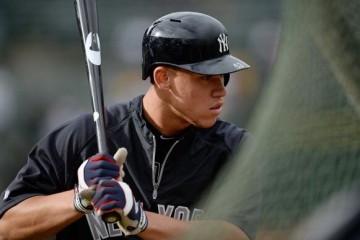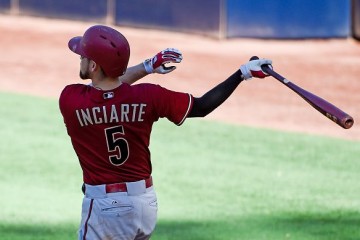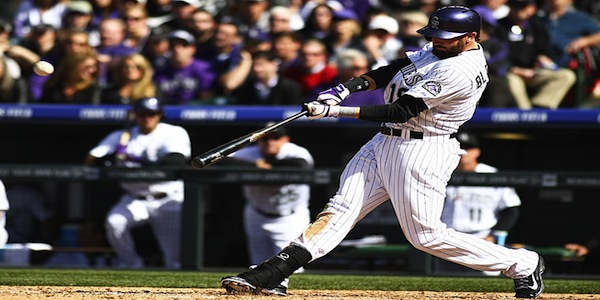2014 Fantasy Baseball: What Can We Expect From Grady Sizemore?


The Boston Red Sox are a fascinating organization. They have the financial wherewithal to play with the big boys and when you look at their overall payroll it certainly looks like they try. Yet, they have experienced more success when they go the other way. In fact, their most successful players have either been home grown or were more or less cast offs from other organizations. David Ortiz might be the best example of that fact.
It shouldn’t be any surprise that when Jacoby Ellsbury left for greener pastures (in New York no less) that the Red Sox went with a cast off. Still, this time they even went outside the norm and brought in someone that hasn’t seen a big league game since 2011 (at least in the dugout). What is motivating them to make Grady Sizemore their everyday centerfielder?
|
AVG |
HR |
Runs |
RBI |
SB |
|
| 2005 |
.289 |
22 |
111 |
81 |
22 |
| 2006 |
.290 |
28 |
134 |
76 |
22 |
| 2007 |
.277 |
24 |
118 |
78 |
33 |
| 2008 |
.268 |
33 |
101 |
90 |
38 |
| 2009 |
.248 |
18 |
73 |
64 |
13 |
When George W. Bush was president it was a much simpler time. We were worried about WMDs, the economy was just beginning to tank and Grady Sizemore was a fantasy stud. It’s been a long time since those days. Now, if you go to Baseball Prospectus and look at his injury record it reads like a busy night at the emergency room in New York or Los Angeles. Even if we look only since 2009, we see that he has seen his fair share of injuries that have landed him on the detail.
|
DL |
Games |
Injury |
Surgery |
Severity |
|
| May 31, 2009 |
Yes |
20 |
Elbow |
No |
Felt Synovitis |
| Sept. 5, 2009 |
Yes |
28 |
Elbow |
Yes |
Debridement |
| May 16, 2010 |
Yes |
128 |
Knee |
Yes |
Microfracture Patella |
| March, 29, 2011 |
Yes |
14 |
Knee |
No |
Microfracture Patella |
| May 11, 2011 |
Yes |
13 |
Knee |
No |
Contusion |
| July 18, 2011 |
Yes |
44 |
Hernia |
Yes |
Sports Hernia |
| Feb. 1, 2012 |
No |
0 |
Knee |
Yes |
Microdiscectomy |
| March 26, 2012 |
Yes |
162 |
Knee |
Yes |
Microdiscectomy |
| Sept. 15, 2012 |
Yes |
0 |
Knee |
Yes |
Microfracture |
My personal favorite was a column that didn’t make it above. The severity column said, “not microfracture.” Boy, that’s a relief. Most of the terms above escape me as I barely made it out of Biology for non-majors in college. However, I can do simple arthimatic, I count more than 400 games lost between 2009 and 2012. That only counts games where he was officially on the disabled list. That doesn’t count games where he missed because he was dinged up or needed to rest because he was sore.
This leads us to wonder what the Red Sox were thinking and what we as fantasy players could expect to get out of someone like Sizemore. This hit closer to home when someone in my experts league offered me Sizemore (and Michael Morse) in exchange for A.J. Burnett. My initial thought was “are you kidding me?”
I politely declined because I simply have to keep all of my pitching right now, but I thought it deserved a harder look. What can we expect out of Grady Sizemore this season? I noticed that his numbers were dropping some in the full seasons above, so I decided to start there. Was there a good reason for some of the slippage in numbers?
|
SO% |
BB% |
Oswing |
Contact |
BABIP |
|
| 2005 |
18.7 |
7.4 |
16.7 |
82.7 |
.334 |
| 2006 |
20.4 |
10.4 |
18.3 |
82.0 |
.339 |
| 2007 |
20.7 |
13.5 |
20.1 |
81.6 |
.333 |
| 2008 |
17.4 |
13.2 |
19.5 |
82.9 |
.290 |
| 2009 |
18.3 |
11.9 |
17.9 |
83.1 |
.275 |
There is a difference between what I would call “process data” and “performance data.” Teams pay a lot of attention to process data. The process data is the data that doesn’t wind up in the box scores. It does help us predict what will happen in the box scores. The Oswing rate (or swings on balls outside the zone) helps us understand whether a hitter is seeing the ball and identifying if it is a ball or strike. The league average is close to 30 percent on swings outside the zone. During his prime, Sizemore’s strike zone judgment was exceptional.
It should be noted that it spiked noticeably in the next two seasons. Sizemore was dealing with a multitude of injuries, so we can discount that as him being unhealthy. If we want to know Sizemore’s best destiny we would look at the numbers above. We see a very good walk rate to go along with the low swing rates. His contact rates are better than the league average (normally around 80 percent) but not quite as good as the Oswing rate. He had a propensity to swing and miss at balls in the zone even then.
If we assume a BABIP of around .300 (again the league average) then we would expect to see a guy that will hit around .260 with 20 home runs and an OBP of around .350. That’s assuming good health. At this point, that is about as safe an assumption as assuming that I will win more than I lose the next time I go to Vegas. If assuming good health is a shaky bet to begin with then what exactly are the Red Sox thinking by going with him in center field?
The answer is pretty simple. They have Jackie Bradley Jr. waiting in the wings. Most teams try to avoid starting rookies on day one of the season, so they can delay their arbitration clock. In a cup of coffee last season, Bradley hit a whopping .189/.280/.337 in 107 plate appearances. He had a sparking .275/.374/.469 mark at Pawtucket that same season. Bradley will turn 24 in April, so there is no reason to absolutely rush him. If Sizemore can buy them four weeks or even six weeks of further development then it will delay Bradley’s arbitration clock. This doesn’t even mention the benefit of Bradley playing every day for another four to six weeks.
That’s a much more reasonable scenario and one that will most likely be the case. The best case scenario is that Sizemore somehow enjoys a renaissance that sees him return to the guy that George W. Bush saw when he was in the White House. If that happens then the Red Sox are likely punching another return trip to the playoffs.





